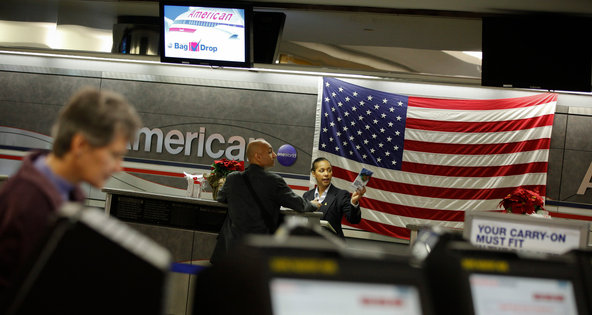 Ángel Franco/The New York TimesThe American Airlines counter at La Guardia Airport in Queens, New York.
Ángel Franco/The New York TimesThe American Airlines counter at La Guardia Airport in Queens, New York.
The AMR Corporation, the parent company of American Airlines, said on Tuesday that it had filed for bankruptcy protection in an effort to reduce labor costs and shed a heavy debt burden.
AMR was the last of the major legacy airlines company in the United States to file for Chapter 11. Analysts said that its reluctance to do so earlier had left it less nimble than many of its competitors.
The company says it intends to operate normally throughout the bankruptcy process, as previous airlines have done. AMR does not expect the restructuring to affect its flight schedule or frequent flier programs.
“Our board decided that it was necessary to take this step now to restore the company’s profitability, operating flexibility and financial strength,” Thomas W. Horton, who was named the company’s chairman and chief executive on Tuesday, said in a statement. Mr. Horton, formerly the company’s president, is succeeding Gerald Arpey, who is retiring.
One of AMR’s chief goals in bankruptcy will be to lower its labor costs.
The company had been in contract talks with its unions until the negotiations stalled earlier this month when the pilots’ union refused to send a proposal to its members for a vote. Because federal bankruptcy rules allow companies to reject contracts, AMR may take a harder negotiating stance with its unions.
“Achieving the competitive cost structure we need remains a key imperative in this process,” Mr. Horton said, “and as one part of that, we plan to initiate further negotiations with all of our unions to reduce our labor costs to competitive levels.”
Once the nation’s biggest airline, AMR began to lose ground in recent years as low-cost carriers like Southwest Airlines grew in prominence. Major airlines were forced to respond by cutting fares.
As competition intensified, AMR responded by borrowing more and more, eventually pledging nearly all of its assets and leaving it heavily indebted. It also sought to reduce expenses, managing to cut $4.1 billion by the end of 2004.
But its principal competitors, including Delta Air Lines and the UAL Corporation’s United Airlines, filed for bankruptcy, shedding billions of dollars in costs and renegotiating labor contracts.
Both also sought mergers to gain scale. Delta paired off with Northwest, and United teamed up with Continental, allowing those airlines to return to profitability.
“Since their restructurings in Chapter 11, AMR’s major network competitors all have lower costs than AMR,” Isabella D. Goren, the company’s chief financial officer, wrote in a court filing.
As part of an effort to cut long-term costs, American earlier this year announced a $38 billion order for 460 new single-aisle planes from Airbus and Boeing, part of a major overhaul of its aging fleet of more than 600 planes that — with an average vintage of 15 years — remains one of the oldest and least fuel-efficient among the six major U.S. carriers.
American expects eventually to shave between 15 percent and 35 percent from its fuel bill with the introduction of the new planes — Airbus A320s and Boeing 737s — which will replace older McDonnell Douglas MD-80s and Boeing 757s and 767s. In an e-mail, Andrea Huguely, an American spokeswoman, said “it is our intent” to take delivery of the new planes as currently scheduled.
In the meantime, the airline has remained unprofitable. AMR has posted annual losses three years in a row, including a $471 million loss last year. It has recorded a $982 million loss through the first nine months of this year.
Given the airline’s shaky financial picture, speculation about an AMR bankruptcy filing also started to increase this year, spooking investors. The company’s stock price has dropped 79 percent in 2011.
As of Sept. 30, AMR reported $24.7 billion in assets and $29.6 billion in debt, according to a filing with the federal bankruptcy court in Manhattan. The company added that it had about $4.1 billion in cash and short-term investments that could be used to pay vendors and suppliers.
The company’s largest unsecured creditors include the Wilmington Trust and the Manufacturers and Traders Trust Company, which represent several classes of bonds.
Nicola Clark contributed reporting.
AMR is being advised by the investment bank Rothschild and the law firms Weil, Gotshal Manges; Paul Hastings; Debevoise Plimpton; and the Groom Law Group.
Article source: http://feeds.nytimes.com/click.phdo?i=5838df46c379c60bac24bb0ac598cc05